When Donald Trump was elected to the United States presidency in late 2016, it was one of the most shocking upsets in election history. As per the Miller Center, Trump won the election even though more people in the country actually voted for his opponent, Hillary Clinton. It was the first time Trump had ever run for any elected office before, and he entered the White House under a cloud of suspicion due to several public scandals.
According to his official biography from the White House, Trump was born in the summer of 1946 as the son of a real estate mogul. He followed in his father’s footsteps, taking over his firm and building a real estate empire for himself. He also built a successful TV career on the back of his reality show, “The Apprentice,” before he ditched Hollywood for Washington D.C.
Trump served only one term in the White House after being defeated by Joe Biden in the 2020 general election. His tumultuous exit was a microcosm of a presidency that was high on public scandals and widely maligned by the press. Let’s take a look at the questionable things about Donald Trump’s presidency.
APPROVING THE KEYSTONE XL PIPELINE
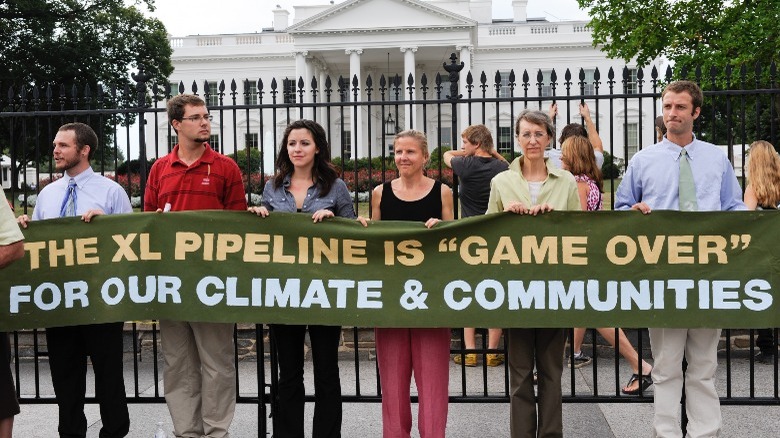 Rena Schild/Shutterstock
Rena Schild/Shutterstock
Though the Keystone XL pipeline was initially proposed in 2008, it became a very contentious point of Donald Trump’s presidency. As the National Resources Defense Council explains, the Keystone XL pipeline was going to be used to ship dirty fossil fuel tar sands oil from Alberta, Canada, down to the Gulf Coast of Texas. The pipeline was expected to transport just shy of 1 million barrels a day.
It was to consist of two different sections, the first of which, from Oklahoma to Texas, had actually already been built. The contested portion was 1,209 miles and would have gone from Alberta to Nebraska. In 2015, the Obama Administration did not give the required authorization for the contested portion of the pipeline to be built. Part of the rationale was based on the severe environmental issues that the pipeline carried with it, including the potential for devastating oil leaks and an increase in greenhouse gas emissions.
Immediately after becoming president, Trump reversed Obama’s decision and issued a Presidential Memorandum welcoming TC Energy to reapply for the pipeline’s approval. Two months later the government issued a permit for construction to start, which was quickly blocked by numerous lawsuits and protests. This led Trump to try and circumvent them by giving the pipeline executive approval, which failed. The issue lasted into Joe Biden’s presidency, where he reversed Trump’s position and revoked the permit from TC Energy, who then abandoned the project for good.
HIS CONTROVERSIAL JUDICIAL NOMINEES
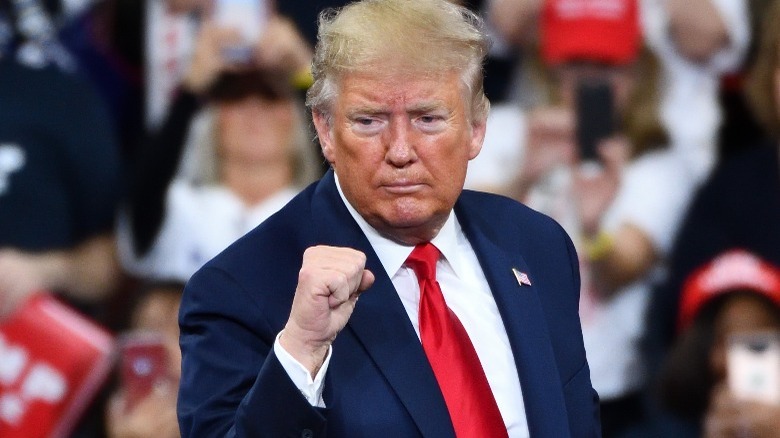 Evan El-Amin/Shutterstock
Evan El-Amin/Shutterstock
According to The Guardian, as of March 2019 Donald Trump had successfully nominated nearly 100 judges to serve in the federal judiciary, an incredible feat. However, it was some of the candidates who failed to get confirmation in the Republican-controlled Senate that raised some eyebrows. In late-2017, three of his nominations were so toxic that he removed them from consideration after it was clear they were going to be voted down in the Senate.
As reported by NPR, one of them was Brett Talley, who was working for the Department of Justice at the time. His nomination fell apart after it emerged that he had not disclosed that his wife worked for Trump’s lawyer. Another was Jeff Mateer, who came under fire for comparing gay marriage to bestiality and making vitriolic remarks about transgender children. The other nominee, Matthew Petersen, was dressed down during one of his confirmation hearings by Sen. John Kennedy. During the cringeworthy hearing, Kennedy showcased Peterson’s inexperience (via CNN) and proved he was not familiar with basic standards for expert witnesses. His nomination was withdrawn soon after.
Other failed nominations were Ryan Bounds and Thomas Farr, as per The Guardian. Both of their nominations hit roadblocks when it came out that they both had previously been involved with racist incidents or writings. As NPR also noted, several of Trump’s nominations were not approved by the American Bar Association, with several of them being given unqualified ratings.
HIS BUSINESS CONFLICTS OF INTEREST
 L.E.MORMILE/Shutterstock
L.E.MORMILE/Shutterstock
One of the biggest questions surrounding Donald Trump when he was elected to office in November 2016 was what was going to happen to his massive real estate and business empire. No other president had entered into office with such glaring conflicts of interest, which were exacerbated by the global extension of his properties. Trump controversially said he was not going to divest himself from his business interests upon taking office, as per Reuters, and his critics have claimed that he unjustly enriched himself at the expense of American taxpayers, as per CNN (via Raw Story).
For example, the Citizens for Responsibility and Ethics in Washington (CREW) tallied over 3,400 conflicts of interest by September of 2020, an average of two-and-a-half per day. Many of the conflicts involved Trump himself, either golfing at his Trump Golf courses or holding political events at Trump properties. He also allowed 141 congressmen and senators and 145 foreign officials to stay at Trump properties, at times charging $650 per room.
According to CREW, even Trump’s vice president contributed to the issue, as his stay in Ireland cost some $600,000 in extra costs due his staying at a Trump resort. Trump also allegedly blocked the construction of a new FBI headquarters because it would have taken revenue away from his Trump Hotel in Washington, D.C. Overall, CREW called Trump’s conflicts of interest some of the worst examples of corruption in modern history.
THE 2017 TRAVEL BANS
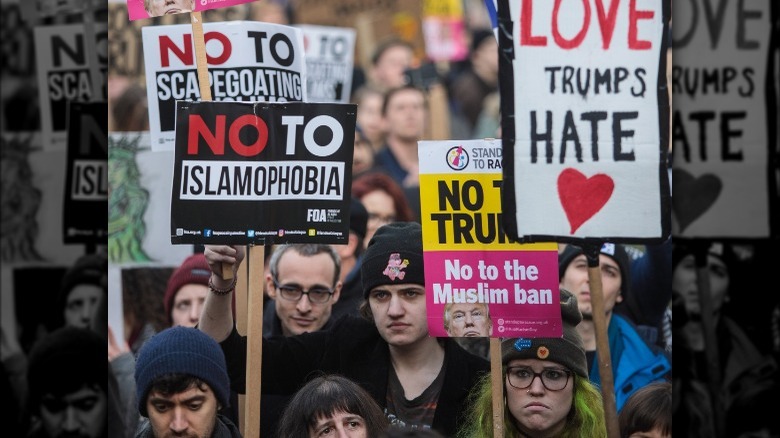 Jack Taylor/Getty Images
Jack Taylor/Getty Images
Donald Trump entered the U.S. presidency as one of the least popular presidents in American history (per the Miller Center), and the actions that he took within his first few months did little to quell the nationwide disgust. His travel bans in particular stood out to many as outrageously egregious and harmful. The travel bans first started on January 27, 2017, when Trump issued Executive Order 13769. The order blocked entry into the U.S. from seven countries — Iran, Iraq, Libya, Syria, Sudan, Somalia, and Yemen — for 90 days.
Per Hamilton College, the order was quickly blocked by a federal judge, and Trump issued a slightly revised second ban in March, Executive Order 13780, which included the same countries, sans Iraq. The second order was also blocked by a federal injunction within a week, but the Supreme Court ruled in June that a modified version of the ban could take effect, as per the ACLU. Groups like the ACLU condemned the ban as a racist “Muslim Travel Ban” because it blocked entry from only countries that had predominantly Muslim populations.
In September 2017, Trump issued even more restrictions on travelers from eight countries — Chad, Iran, Libya, North Korea, Somalia, Syria, Venezuela and Yemen — through Presidential Proclamation 9645. Amidst various lawsuits and federal injunctions the Supreme Court again ruled the travel ban was legal, much to the outrage of Democratic lawmakers and liberal groups (per CNN). When Joe Biden entered office he officially rescinded the controversial travel bans, ending them for good, reports NPR.
THE CONTROVERSIAL CHILD SEPARATION POLICY
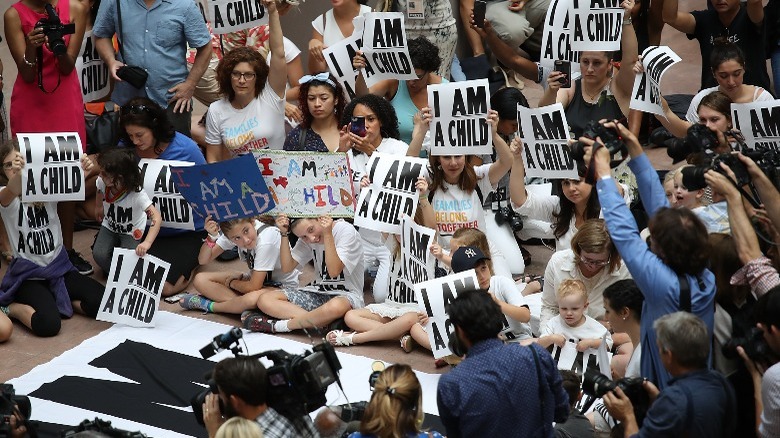 Win Mcnamee/Getty Images
Win Mcnamee/Getty Images
The southern border was a contentious issue during Donald Trump’s presidential campaign, and within a month and a half of taking office his policies surrounding it were already making headlines. As Reuters reported in early March 2017, Trump’s administration was considering implementing a policy that would separate the families of immigrants detained for illegally crossing the border. Parents would be separated from their children as a deterrent to other potential immigrants who were thinking about coming to the border with their kids.
This marked a change in policy, where previously families were generally kept together during asylum and deportation hearings. It was not until June 2018 that the administration finally revealed they had separated over 2,000 children from their parents under the new policy (via CNN). When journalists visited a facility housing migrant children days later they found abhorrent conditions and saw kids locked in cages (per the Associated Press). There was widespread public outrage over the revelations, with accusations of neglect and people calling the policy “inhumane.”
CBS reported that Trump, under severe pressure, signed an executive order canceling the separation policy on June 20. The Guardian reported a week later that a judge issued an injunction on the policy and had ordered the separated families to be reunited. However, the administration still separated nearly 1,100 people after the injunction and in total separated over 5,400 migrant children from their parents (via the Associated Press).
WITHDRAWING FROM THE PARIS CLIMATE AGREEMENT
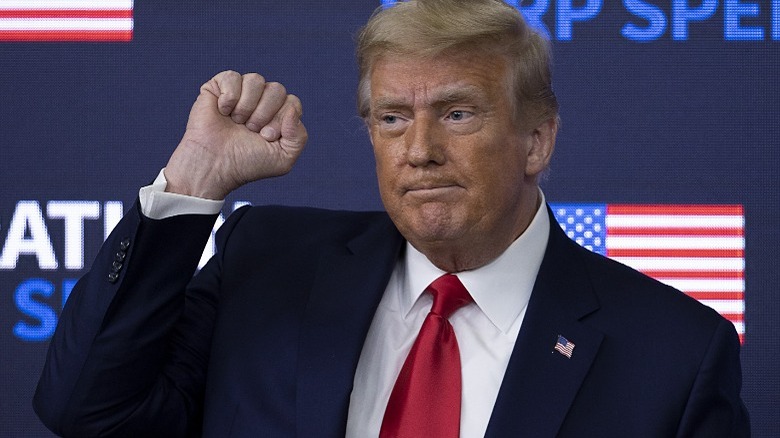 Tasos Katopodis/Getty Images
Tasos Katopodis/Getty Images
In December 2015, world leaders from around the globe entered into the Paris Climate Agreement, which is aimed at fighting climate change on a global level by reducing greenhouse gas emissions. The following September, President Barack Obama officially entered the U.S. as a signatory to the agreement (per the White House). However, as Scientific American reported in June 2017, newly inaugurated president Donald Trump announced he would be taking the U.S. out of the agreement.
Many prominent scientists blasted Trump’s proposal, with one calling it an “irresponsible and callous dismissal of the health, safety, and economic well-being of Americans,” while another called the decision “as shortsighted as it is disheartening.” Many scientists took issue with what they perceived as Trump’s misrepresentation of climate science and argued the ramifications of leaving the agreement would affect many Americans — especially those in the lower socioeconomic classes.
As Columbia University acknowledged at the time, Trump was prohibited from actually leaving the agreement for three years, due to the policies of agreement that Obama had entered. Yet, in November of 2020, the U.S. officially removed itself as a signatory to the agreement (per Scientific American). Significantly, many U.S. states and municipalities actually implemented their own renewable energy strategies in response to Trump leaving the agreement. When Joe Biden became president in 2021, one of his first acts was to recommit the U.S. to the agreement, completely undoing Trump’s actions (from the White House).
HIS VARIOUS PARDONS OF QUESTIONABLE PEOPLE
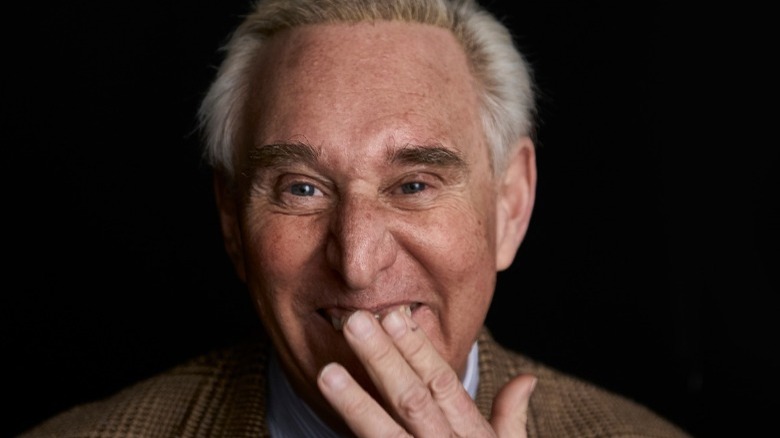 Cornelius O/Shutterstock
Cornelius O/Shutterstock
When Donald Trump left the White House in January 2021, he had used his clemency powers a total of 237 times over the previous four years. According to the Pew Research Center, while this may sound like a high number, it was actually the third lowest over the past 120 years. He is tied with George W. Bush for having the lowest percentage of requests granted among modern presidents, as he refused to grant more than 11,000 requests.
Yet, while the number of pardons did not rankle observers, it was the timing of them and the people who were pardoned that drew sharp criticism. According to The New York Times, Trump issued 143 of his acts of clemency in the waning weeks of his presidency — well over half of his total. He pardoned multiple Republicans who had been convicted of crimes while in office, as well as former associates of his who were either under indictment or had previously been convicted of crimes.
Among the most controversial pardons were Stephen Bannon, his former chief strategist who was charged with fraud; Roger Stone, another former associate who was convicted of multiple felonies in related to his work on the Trump Campaign; and Joe Arpaio, the former Arizona sheriff who was convicted of criminal contempt for enforcing racial profiling policies during his time in law enforcement.
SIGNING THE AFGHAN PEACE AGREEMENT
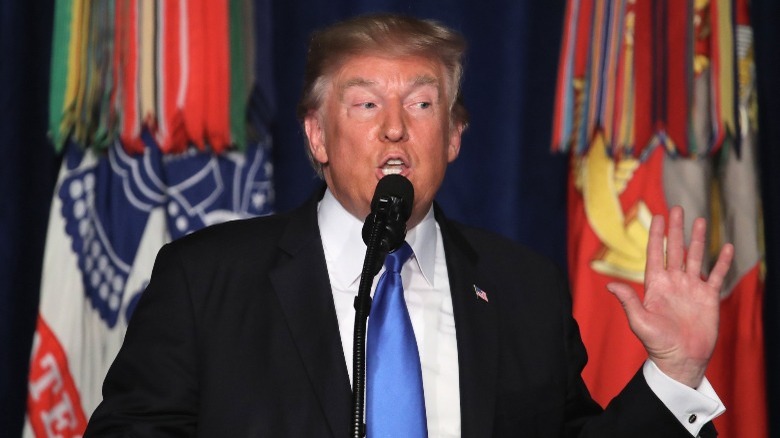 Mark Wilson/Getty Images
Mark Wilson/Getty Images
The U.S. exit from Afghanistan in the summer of 2021 was one of the messiest and most convoluted military debacles in recent history. Unfortunately, many observers saw the writing on the wall back in February 2020 when Donald Trump signed the Afghanistan peace agreement. The peace agreement was quickly repudiated by critics, who charged it with numerous problems.
As the Council on Foreign Relations (CFR) pointed out, the U.S. had originally gone into Afghanistan two decades prior to fight the Taliban, who had been sheltering and aiding the terrorist group Al-Qaeda, the group responsible for carrying out the devastating 9/11 terrorist attacks. When Trump signed the 2020 peace agreement, he did so with the Taliban. However, as Bruce Riedel, a senior fellow at a Middle East policy think tank, pointed out at the Brookings Institution, the Taliban were not the officially recognized government of Afghanistan. That government, led by Ashraf Ghani, was not included in the negotiations at the behest of the Taliban.
This constituted what Riedel called a “fundamental flaw” in the agreement, which he compared with the disastrous Paris Peace Accords from the Vietnam War. When the treaty was signed, critics also argued that it would be unwise to commit to the withdrawal of U.S. troops prematurely, and it would lead to instability and the oppression of women’s rights. Eventually, many of these fears were realized when the troops were finally brought home in August 2021 as Afghanistan collapsed (via NBC).
DOWNPLAYING THE COVID-19 PANDEMIC
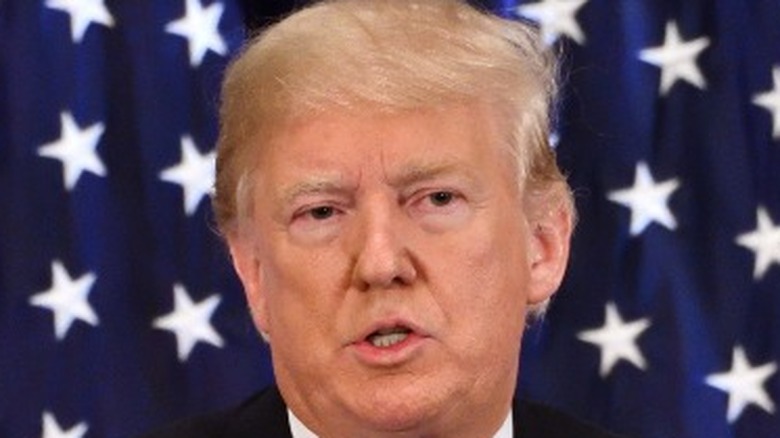 Evan El-Amin/Shutterstock
Evan El-Amin/Shutterstock
In the spring of 2020, the COVID-19 virus took over the entire world by storm. Businesses were forced to shut down, countries closed their doors to foreign travelers, and people started sheltering in their houses for fear of getting deathly ill. There was massive amounts of misinformation spread around, and some people struggled to determine what was fact and what was fiction.
As NPR reported, in the early months of the pandemic, President Donald Trump seemed to publicly dismiss its severity. He made statements claiming the disease would be gone by April, and he compared it with the seasonal flu — insinuating it was not very harmful. However, while he was making all of these statements in public, his personal tone was quite different. As Bob Woodward reported in his book, “Rage,” Trump stated that he purposefully downplayed how dangerous the virus was because he didn’t want to cause panic. He did so despite saying privately that the virus was more dangerous than he was letting on.
He started to suggest alternative treatments, like hydroxychloroquine, instead of promoting social distancing measures. According to NPR, studies showed that the delay in public health measures, like social distancing, contributed to tens of thousands of unnecessary deaths and almost a million infections.
TRUMP RECOGNIZED JERUSALEM AS ISRAEL’S CAPITAL
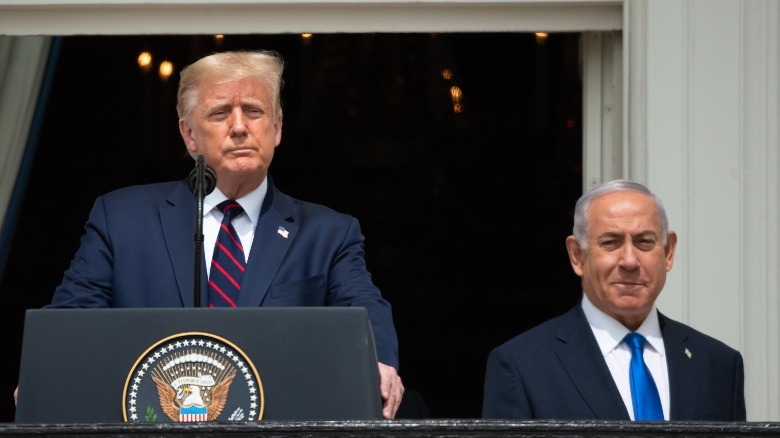 noamgalai/Shutterstock
noamgalai/Shutterstock
On May 14, 2018, just over a year into Donald Trump’s presidency, the country of Israel celebrated the 70th anniversary of their founding. For many Israelis, the time was a joyous occasion to celebrate the past seven decades of history. Yet for many Palestinians, the celebration was also a bitter reminder of that very same history. That same day, as Vox explains, the U.S. officially recognized Jerusalem as the Israeli capital and opened the newly built U.S. Embassy there, too — igniting a wave of criticism
The move was very controversial for a number of reasons. Not only did Trump split with the established U.S. precedent of not officially recognizing Jerusalem for either the Israelis or Palestinians, but it came amidst an incredibly volatile time in the Israeli-Palestinian conflict. As the embassy was opening, Palestinian activists were in the midst of a nearly two-month long protest over the Gaza Strip near the Egyptian border, and over 60 of them had been killed by Israeli soldiers.
The move looked incredibly insensitive at the time, and it made it seem like Trump and the U.S. were actively siding with the Israelis over the Palestinians. The opening of the embassy also directly preceded the Palestinian day of remembrance for the loss of their land during the 1949 war, known as Nakba Day. All of this served to inflame tensions at an already volatile time in the area.
THE 2020 IRANIAN MISSILE STRIKES
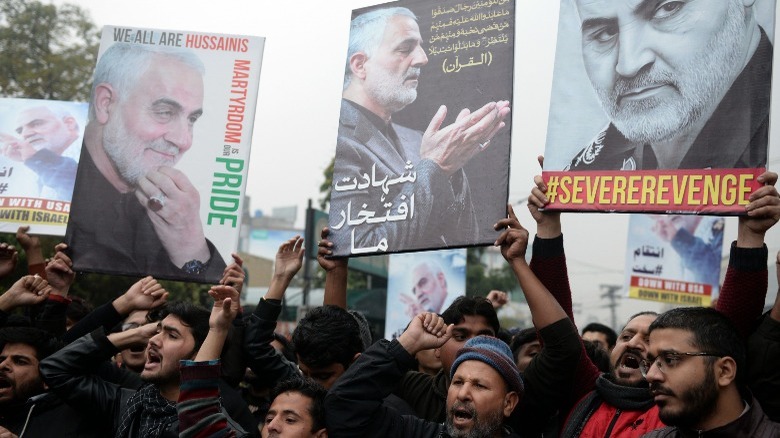 A M Syed/Shutterstock
A M Syed/Shutterstock
In early-January of 2020, The New York Times dropped a pretty substantial bombshell. Donald Trump’s administration had just launched a barrage of missile strikes at the Islamic Republic of Iran. One of the drone strikes had killed Qassim Suleimani, who was Iran’s head commander and the leader of the Quds Force of the Islamic Revolutionary Guards Corps. The Times called Suleimani’s death a major blow for the country and considered the strikes a huge step in Trump’s challenge of Tehran. The Pentagon stated that the strike took place because Suleimani was planning on attacking American diplomats.
Then, Trump inflamed tensions further when he threatened Iran over any retaliatory strikes, tweeting he would bomb a number of Iran’s sacred and cultural sites (via Al-Jazeera). The tweets drew immediate international condemnation, with many pointing out it was illegal to do so under the United Nations’ charter. The Pentagon even had to come out and clarify the targeted bombings of cultural and heritage sites would not commence (per Al-Jazeera).
However, Iran did respond. As per Time, less than a week later the Iranian military fired several ballistic missiles at military bases where U.S. forces were being housed, though no one was injured. Iran claimed that the response was legal under Article 51 from the U.N. charter and called Trump’s attacks signs of a weak leader. Eventually tensions settled, but the entire event was very dangerous.
NOMINATING AMY CONEY BARRETT TO THE SUPREME COURT
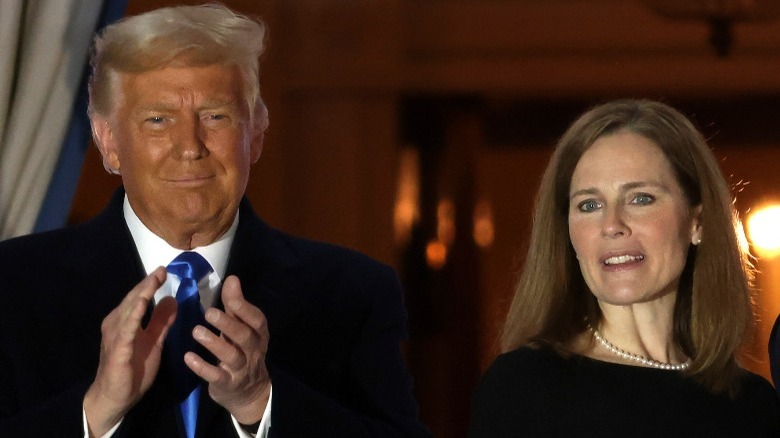 Alex Wong/Getty Images
Alex Wong/Getty Images
One of Donald Trump’s last acts in office was also one of his most controversial. In late-September 2020, less than two months before the presidential election, Supreme Court Justice Ruth Bader Ginsburg passed away from complications due to cancer (per The New York Times). Her death came as a shock to many, and the question of who would succeed her on the court was quickly on people’s minds.
Almost immediately, Trump nominated conservative judge Amy Coney Barrett to fill her seat on the court. While Barrett herself wasn’t an especially controversial choice, the timing surrounding her nomination was. The New York Times argued that Republicans rushed to fill the vacant Supreme Court seat before the upcoming elections, when they would potentially lose the Senate and thus the ability to confirm Barrett in a new Congress.
This was in complete contradiction to the failed nomination of Merrick Garland during the Barack Obama Administration, when Republicans refused to vote on the nominee because it was too close to the 2016 election. No Democrats supported Barrett’s confirmation, the first time a justice had been confirmed to the court without a bipartisan vote in over 150 years.
Read More: https://www.grunge.com/1021074/questionable-things-about-donald-trumps-presidency/?utm_campaign=clip
BY CHANDLER STARK
Grunge





























